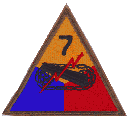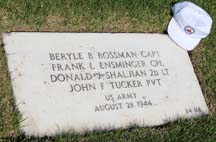


(MOS in parens) Click on name for IDPF.
I am also including (listed next to last) 2 men of A/3rd Cavalry Reconnaissance Squadron reportedly lost at Épernay. I am also including (listed last) George T. Miranda of B/33rd Armd Engr Bn who was mortally wounded this day but probably not at Épernay.
At this point, I cannot reconcile the 3rd Cavalry Reconnaissance Squadron account with the 7th Armored Division account, neither of which mentions the other at Épernay. |
|
Before going into the specifics of the events, it is important to note the following so as not to arrive at erroneous understanding of the events.
|
|
Cpl. Virgil S. Stephens Company A, 31st Tank Battalion By far the most complicated deaths to understand are those of Capt. Davis and Cpl. Stephens. They were the only members of Company A, 31st Tank Battalion, lost that day. But their loss was not included in the Morning Reports until 4 days later when they are reported Missing in Action as of 28 Aug 1944 in the A/31 Morning Report of 1 Sep 1944. The Individual Deceased Personnel File of Capt. Davis is a PDF file of 209 pages -- the largest of any 7th Armored Division IDPF. 28 Aug 1944: A/31 Morning Report
Undated, but on or before 7 Sep 1945: "Check List for Disinterment of Unknowns"
7 Sep 1944: Burial at Champigneul
19 Sep 1944: 3041st Quartermaster Graves Registration "Supplemental information covering bodies, Unknown X-7, Unknown X-8"
2 May 1946: Initial Identification
15 May 1945: 7th Armored Division Headquarters challenge of the identification
The information about Capt. Davis' body in the statement of 1st Lt. Thomas F. Sullivan (inclosure 4) gives us the only information we have about where and how Capt. Davis was killed. He was killed in his tank, which was also disabled. Lt. Sullivan "helped to remove Capt Davis' dead body from his disabled tank". In fact, we do have more information in Capt. Davis' IDPF. When his remains were disinterred 19 Aug 1948 (PDF p 6), the condition of his remains was noted as "Multiple fractures upper extremties". This is very much in line with the description given to me 28 Sep 2002 by 3/A/31 veteran Joie Gjernes who said the Capt. Davis was the A/31 commanding officer and that he was killed while his tank was crossing a bridge. He was killed by a shell that hit the tank in the turret where Capt. Davis was standing, and the shell pretty much cut Capt. Davis in half. The 7AD challenge seems based primarily on two apparent discrepancies in the records supplied by Graves Registration. First (para 2d), 7AD HQ cites the fact that the Report of Burial of X-8 (PDF pp 149-150) shows no clothing information. It refers to the supplemental information sheet (PDF p 10), but that too has no clothing information. Graves Registration did not sent 7AD the Disinterment Checklist that gave the information about X-8 wearing clothing marked as Capt. Davis. Thus 7AD's challenge was valid but only because they had not received all the information from Graves Registration. The second basis of 7AD's challenge was based on yet another flaw in what they reported: the supplemental information sheet (PDF p 10) seriously mischaracterized what had happened and confused a C/31 survivor with an A/31 death and tank. Once again, 7AD's challenge was valid but only because of the faulty Graves Registration supplemental information. So, Graves Registration's identification of X-8 Champigneul as Capt. Davis was correct. But 7AD's challenge of that identification was also correct, based on the incomplete and flawed information provided to 7AD by Graves Registration. 21 Feb 1949: Dental Match Confirmation
25 Mar 1949: Summary of Identification
Cpl. Virgil S. Stephens
The same 1 Sep 1944 A/31 Morning Report that shows Capt. Davis as Missing in Action as of 28 Aug also shows Cpl. Stephens as Missing in Action as of 28 Aug. And the same 7 Nov 1944 A/31 Morning Report that changed the status of Capt. Davis is Killed in Action as of 28 Aug also shows the status of Cpl. Stephens changed to Killed in Action as of 28 Aug. The 7 Sep 1944 Report of Burial (PDF p 40) shows that the burial team surmised his cause of death as "KIA, Head severed". When he was disinterred from the Champigneul, France, temporary US military cemetery for repatriation (PDF p 6), the condition of his remains was documented as "Skeleton, multiple fractures with extremeties missing, R/clavicle, and scapula". So, his head was apparently present. My current conjecture is that he was the bow gunner of Capt. Davis' tank. He may have been sitting with his head above the lower hatch when the shell that killed Capt. Davis took off the head of Virgil Stephens just before it hit the turret in which Capt. Davis was standing. |
|
2d Lt. Donald Joseph Shaljian (1203) Company C, 31st Tank Battalion The IDPF of Capt. Davis of A/31 has survivor accounts from the tank of Lt. Shaljian (Davis IDPF pp 120-123). Since only two crew members survived, it seems likely that one of the C/31 gunners killed (either Ensminger or Sroka) was a member of this crew. |
|
T/5 John D. Smith Troop A, 3rd Cavalry Reconnaissance Squadron The post-war (1949) book The 3rd Cavalry Reconnaissance Squadron (Mecz.) in World War II, 9 August 1944 to 9 May 1945 gives the following account (PDF pp. 93-94) of events 28 Aug 1944 at Épernay:
The problem with this account is that it makes no mention of 7th Armored Division, and the 7th Armored Division After Action Reports (7AD, CCB, 31st Tank, 33rd Engineers) make no mention of 3rd Cavalry. Furthermore, the Individual Deceased Personnel File of Cpl. Cumbo has no information about where he or how he was killed and shows his remains were collected by Graves Registration from Provins, which is a bit over 50 miles south of Épernay so that it makes death at Épernay very unlikely. In the extensive folder of 3rd Cavalry Group combat interviews (National Archives RG 407 Entry 427 Box 24106 [in 2004] Folder 321), there is a copy of the Group's August 1944 After Action Report. The following account is from page 2 of that report.
At this point, I cannot reconcile the 3rd Cavalry Reconnaissance Squadron account with the 7th Armored Division account, neither of which mentions the other at Épernay. The 7AD After Action Report places entry to the town at 1800 while the 3rd Cav report places entry at 1700. So, it is possible that both are accurate and that neither knew of the other. |
|
Company B, 33rd Armored Engineer Battalion T/5 George Miranda was wounded on 28 Aug 1944 and died the next day, 29 Aug 1944, at the 35th Evacuation Hospital. I researched his death in case he was a casualty at Épernay, but I think it is most likely that he was wounded somewhere along B/33's route from Saint Loup to Avize, France, which is the route shown by the B/33 Morning Report. The 2d and 3rd platoons of B/33 were attached to 31st Tank Battalion at this time. However, the B/33 Morning Report locations do not place them at Épernay. |
Active overview of all pages at the 7th Armored Division web site